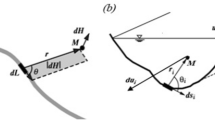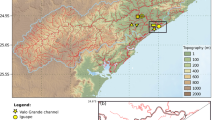Abstract
The timing of variables for stream flow prediction models remains a common problem, particularly with regards to stream flow data-driven based models. Accurate estimation of lag time (Lt), which is representative of time interval, is a potential solution to this problem. The main objective of this paper is to explore possibilities of improving the performance of stream flow data-driven based models by developing a new and simple hydrological approach to accurately estimate Lt between upstream and downstream stations in the Selangor River Basin. The Lt was estimated by means of several empirical formulas along with the new proposed approach that is based on observed hourly stream flow records and water level data. The estimated Lt was used to select the input and output variables for two Multiple Linear Regression models (MLR)—as examples of data-driven based models—to explore the capacity to enhance stream flow data-driven based model performance. An assessment of the two models’ result performance indicates that the MLR model, which is dependent on the proposed method, produced roughly 5 % overall improvement in root mean squared error (RMSE), mean absolute error (MAE) and mean absolute percentage error (MAPE). Not only do the results highlight how effective the proposed approach is in estimating Lt to improve the stream flow MLR model’s performance, but they also serve as a starting point to further study potential improvements from other types of data-driven based models.






Similar content being viewed by others
References
Abrahart RJ, Heppenstall AJ, See LM (2007) Timing error correction procedure applied to neural network rainfall—runoff modelling. Hydrol Sci J 52(3):414–431. doi:10.1623/hysj.52.3.414
Akbari M, Afshar A, Sadrabadi MR (2009) Fuzzy rule based models modification by new data: application to flood flow forecasting. Water Resour Manag 23(12):2491–2504. doi:10.1007/s11269-008-9392-z
Akhtar MK, Corzo GA, van Andel SJ, Jonoski A (2009) River flow forecasting with artificial neural networks using satellite observed precipitation pre-processed with flow length and travel time information: case study of the Ganges river basin. Hydrol Earth Syst Sci 13(9):1607–1618. doi:10.5194/hess-13-1607-2009
Allen JRL (1976) Computational models for dune time-lag: general ideas, difficulties, and early results. Sediment Geol 15(1):1–53. doi:10.1016/0037-0738(76)90020-8
Aqil M, Kita I, Yano A, Nishiyama S (2007) Neural networks for real time catchment flow modeling and prediction. Water Resour Manag 21(10):1781–1796. doi:10.1007/s11269-006-9127-y
Askew AJ (1970) Derivation of formulae for variable lag time. J Hydrol 10(3):225–242. doi:10.1016/0022-1694(70)90251-9
Bhadra A, Bandyopadhyay A, Singh R, Raghuwanshi NS (2010) Rainfall-runoff modeling: comparison of two approaches with different data requirements. Water Resour Manag 24(1):37–62. doi:10.1007/s11269-009-9436-z
Daniel EB, Camp JV, LeBoeuf EJ, Penrod JR, Dobbins JP, Abkowitz MD (2011) Watershed modeling and its applications: a state-of-the-art review. Open Hydrol J 5:26–50
de Vos NJ, Rientjes THM (2005) Constraints of artificial neural networks for rainfall-runoff modelling: trade-offs in hydrological state representation and model evaluation. Hydrol Earth Syst Sci 9(1/2):111–126. doi:10.5194/hess-9-111-2005
Dutta D, Welsh W, Vaze J, Kim SH, Nicholls D (2012) A comparative evaluation of short-term streamflow forecasting using time series analysis and rainfall-runoff models in ewater source. Water Resour Manag 26(15):4397–4415. doi:10.1007/s11269-012-0151-9
Evans J (1966) Straightforward statistics for the behavioral sciences. Brooks/Cole Pub. Co, Pacific Grove
Fang X, Cleveland T, Garcia C, Thompson D, Malla R (2005) Literature review on timing parameters for hydrographs. Department of Civil Engineering, Lamar University, Beaumont
Fang X, Thompson D, Cleveland T, Pradhan P, Malla R (2008) Time of concentration estimated using watershed parameters determined by automated and manual methods. J Irrig Drain Eng 134(2):202–211. doi:10.1061/(ASCE)0733-9437(2008)134:2(202)
Gopakumar R, Takara K, James EJ (2007) Hydrologic data exploration and river flow forecasting of a humid tropical river basin using artificial neural networks. Water Resour Manag 21(11):1915–1940. doi:10.1007/s11269-006-9137-9
Green JI, Nelson EJ (2002) Calculation of time of concentration for hydrologic design and analysis using geographic information system vector objects. J Hydroinf 4(2):75–81
Grimaldi S, Petroselli A, Tauro F, Porfiri M (2012) Time of concentration: a paradox in modern hydrology. Hydrol Sci J 57(2):217–228. doi:10.1080/02626667.2011.644244
Hassan AJ, Ghani AA, Abdullah R (2004) Development of flood risk map using GIS for Sg. Selangor Basin. National Hydraulic Research Institute of Malaysia, Malaysia
Kentel E (2009) Estimation of river flow by artificial neural networks and identification of input vectors susceptible to producing unreliable flow estimates. J Hydrol 375(3–4):481–488. doi:10.1016/j.jhydrol.2009.06.051
Khalil A, Almasri MN, McKee M, Kaluarachchi JJ (2005) Applicability of statistical learning algorithms in groundwater quality modeling. Water Resour Res 41(5), W05010. doi:10.1029/2004WR003608
Kirpich ZP (1940) Time of concentration of small agricultural watersheds. Civ Eng 10(6):362–368
Kisi O, Nia A, Gosheh M, Tajabadi M, Ahmadi A (2012) Intermittent streamflow forecasting by using several data driven techniques. Water Resour Manag 26(2):457–474. doi:10.1007/s11269-011-9926-7
Lee CM (2002) Master plan study on flood mitigation and river management for Sg. Selangor River Basin., vol 2. Drainage and Irrigation Department (DID) Malaysia
Li M-H, Chibber P (2008) Overland flow time of concentration on very flat terrains. J Transp Res Board 2060(15):133–140. doi:10.3141/2060-15
Loukas A, Quick MC (1996) Physically-based estimation of lag time for forested mountainous watersheds. Hydrol Sci J 41(1):1–19. doi:10.1080/02626669609491475
McCuen R (2009) Uncertainty analyses of watershed time parameters. J Hydrol Eng 14(5):490–498. doi:10.1061/(ASCE)HE.1943-5584.0000011
McCuen R, Wong S, Rawls W (1984) Estimating urban time of concentration. J Hydraul Eng 110(7):887–904. doi:10.1061/(ASCE)0733-9429(1984)110:7(887)
McMillan HK, Hreinsson EÖ, Clark MP, Singh SK, Zammit C, Uddstrom MJ (2013) Operational hydrological data assimilation with the recursive ensemble Kalman filter. Hydrol Earth Syst Sci 17(1):21–38. doi:10.5194/hess-17-21-2013
Nagesh Kumar D, Srinivasa Raju K, Sathish T (2004) River flow forecasting using recurrent neural networks. Water Resour Manag 18(2):143–161. doi:10.1023/B:WARM.0000024727.94701.12
Nelson W, Bruce (2002) An unusual turbidity maximum. In: Johan CW, Cees K (eds) Proceedings in Marine Science, vol 5. Elsevier, pp 483–497. doi:10.1016/s1568-2692(02)80035-3
Nilsson P, Uvo CB, Berndtsson R (2006) Monthly runoff simulation: comparing and combining conceptual and neural network models. J Hydrol 321(1–4):344–363. doi:10.1016/j.jhydrol.2005.08.007
Pavlovic S, Moglen G (2008) Discretization issues in travel time calculation. J Hydrol Eng 13(2):71–79. doi:10.1061/(ASCE)1084-0699(2008)13:2(71)
Perugu M, Singam A, Kamasani C (2013) Multiple linear correlation analysis of daily reference evapotranspiration. Water Resour Manag 27(5):1489–1500. doi:10.1007/s11269-012-0250-7
Reed DW, Johnson P, Firth JM (1975) A non-linear rainfall-runoff model, providing for variable lag time. J Hydrol 25(3–4):295–305. doi:10.1016/0022-1694(75)90027-X
Saghafian B, Julien PY (1995) Time to equilibrium for spatially variable watersheds. J Hydrol 172(1–4):231–245. doi:10.1016/0022-1694(95)02692-I
Samsudin R, Saad P, Shabri A (2011) River flow time series using least squares support vector machines. Hydrol Earth Syst Sci 15(6):1835–1852. doi:10.5194/hess-15-1835-2011
Samuel B, Lloyd DN, Carlos RM (2012) Hydrological prediction in a tropical watershed dominated by oxisols using a distributed hydrological model. Water Resour Manag. doi:10.1007/s11269-012-0189-8
Shafie A (2009) Extreme flood event: a case study on floods of 2006 and 2007 in Johor, Malaysia. Colorado State University, Fort Collins
Sharifi S, Hosseini S (2011) Methodology for Identifying the Best Equations for Estimating the Time of Concentration of Watersheds in a Particular Region. Journal of Irrigation and Drainage Engineering 137 (11):712–719. doi:doi:10.1061/(ASCE)IR.1943-4774.0000373
Singh VP (1976) Derivation of time of concentration. J Hydrol 30(1–2):147–165. doi:10.1016/0022-1694(76)90095-0
Singh VP (1988) Hydrologic systems: rainfall-runoff modeling, vol I. Prentice Hall, New Jersey
Solomatine D, See LM, Abrahart RJ (2008) Data-driven modelling: concepts, approaches and experiences. In: Abrahart R, See L, Solomatine D (eds) Practical hydroinformatics, vol 68. Water Science and Technology Library. Springer, Berlin, pp 17–30. doi:10.1007/978-3-540-79881-1_2
Subramaniam V (2004) Managing water supply in Selangor and Kuala Lumpur. BULETIN INGENIEUR, vol 22. The board of engineers Malaysia, 50580 Kuala Lumpur, Malaysia
Sudheer KP, Gosain AK, Ramasastri KS (2002) A data-driven algorithm for constructing artificial neural network rainfall-runoff models. Hydrol Process 16(6):1325–1330. doi:10.1002/hyp.554
Talei A, Chua LHC (2012) Influence of lag time on event-based rainfall–runoff modeling using the data driven approach. J Hydrol 438–439:223–233. doi:10.1016/j.jhydrol.2012.03.027
Toth E (2008) Data-driven streamflow simulation: the influence of exogenous variables and temporal resolution. In: Abrahart R, See L, Solomatine D (eds) Practical hydroinformatics, vol 68. Water Science and Technology Library, Springer, Berlin, pp 113–125. doi:10.1007/978-3-540-79881-1_9
van Breemen MTJ (2008) Salt intrusion in the Selangor Estuary in Malaysia. University of Twente, The Netherlands
Varoonchotikul P (2003) Flood forecasting using artificial neural networks. Balkema, Rotterdam
Viessman W, Lewis GL (2003) Introduction to hydrology, 5th edn. Pearson Education, United States of America
Woodward DE (2010) National engineering handbook, part 630 Hydrology, chapter 15: Time of concentration national engineering handbook, vol part 630 Hydrology. United States Department of Agriculture, Natural Resources Conservation Service
Yu Y-B, Wang B-D, Wang G-L, Li W (2004) Multi-person multiobjective fuzzy decision-making model for reservoir flood control operation. Water Resour Manag 18(2):111–124. doi:10.1023/B:WARM.0000024705.63932.3c
Acknowledgments
The authors acknowledge the support rendered by the Hydrology and Water Resources Division of the Department of Irrigation and Drainage (DID), Malaysia. Special thanks are due to MIS (Malaysian International Scholarship, MOHE) and ACP-JSPS (Asian Core Program) for their support in the study. The authors would also like to acknowledge the financial assistance from grant FL026-2012D for this research. We are most grateful and would like to thank the reviewers for their valuable suggestions that have led to substantial improvements to the article.
Author information
Authors and Affiliations
Corresponding author
Rights and permissions
About this article
Cite this article
Seyam, M., Othman, F. The Influence of Accurate Lag Time Estimation on the Performance of Stream Flow Data-driven Based Models. Water Resour Manage 28, 2583–2597 (2014). https://doi.org/10.1007/s11269-014-0628-9
Received:
Accepted:
Published:
Issue Date:
DOI: https://doi.org/10.1007/s11269-014-0628-9




